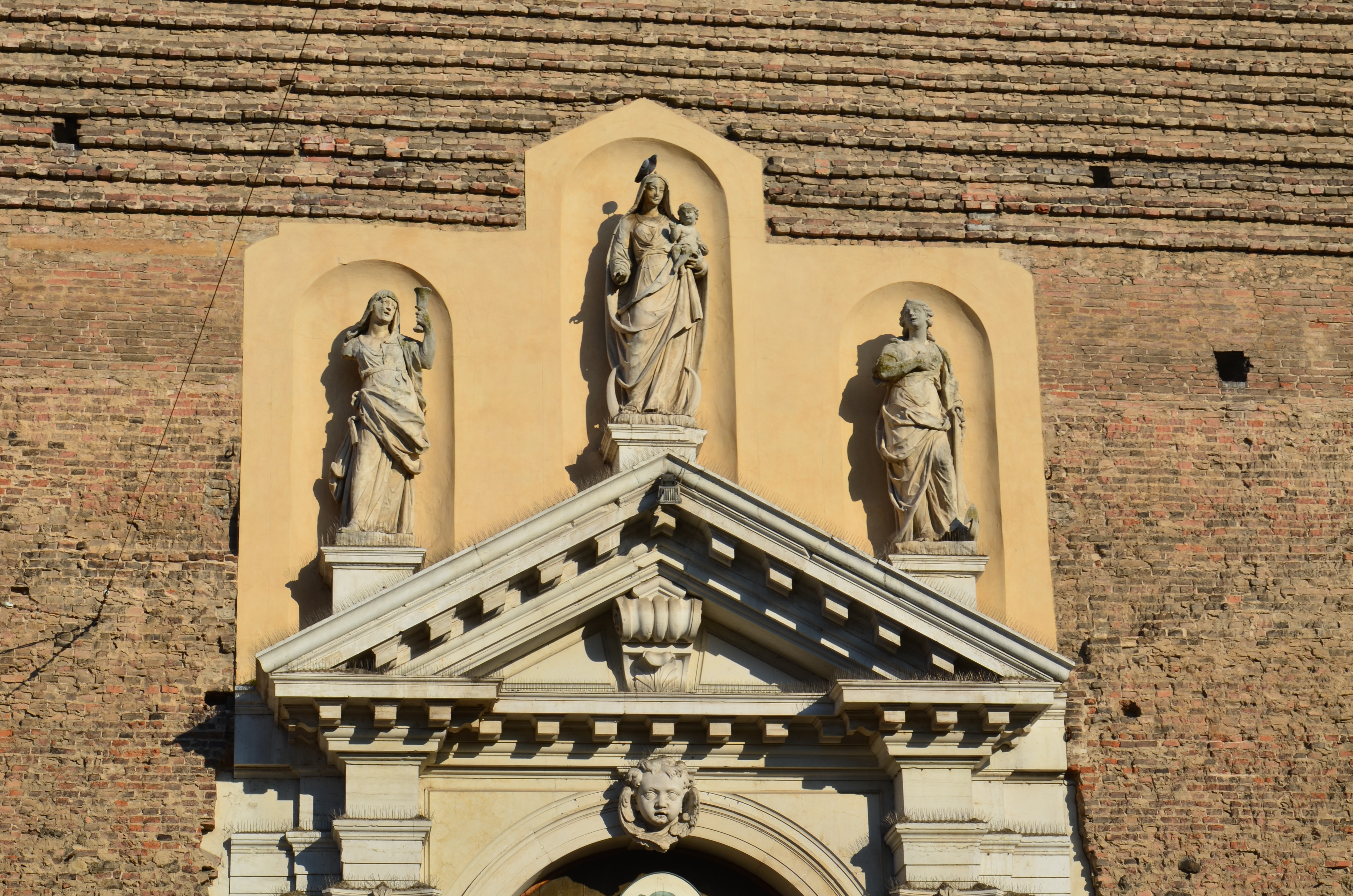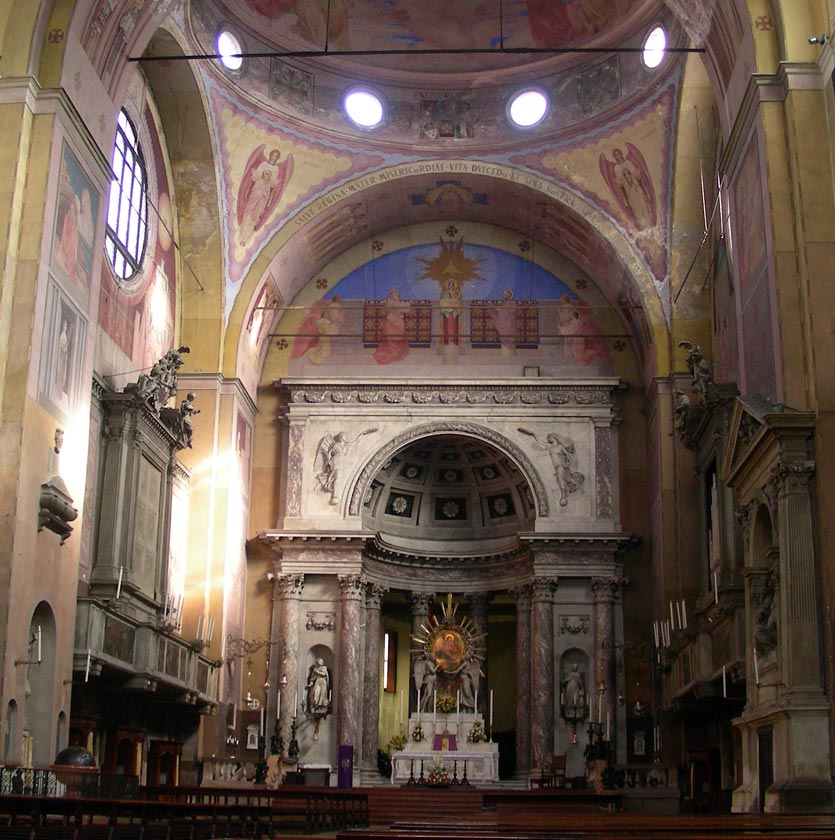Basilica Del Carmine, Padua on:
[Wikipedia]
[Google]
[Amazon]
 The Basilica del Carmine is a 16th-century
The Basilica del Carmine is a 16th-century
 The main portal was completed in 1412, with statues by Bonazza added in 1736–1737. The piazza in front of the church has a statue of
The main portal was completed in 1412, with statues by Bonazza added in 1736–1737. The piazza in front of the church has a statue of
 The counterfacade has a canvas depicting the ''Annunciation'' by
The counterfacade has a canvas depicting the ''Annunciation'' by  The pavement is made from polychrome marble. The ''Polyptych of Lazarus'' by
The pavement is made from polychrome marble. The ''Polyptych of Lazarus'' by
 The Basilica del Carmine is a 16th-century
The Basilica del Carmine is a 16th-century Roman Catholic
Roman or Romans most often refers to:
*Rome, the capital city of Italy
*Ancient Rome, Roman civilization from 8th century BC to 5th century AD
*Roman people, the people of ancient Rome
*'' Epistle to the Romans'', shortened to ''Romans'', a lette ...
church located on piazza Francesco Petrarca in Padua
Padua ( ; it, Padova ; vec, Pàdova) is a city and ''comune'' in Veneto, northern Italy. Padua is on the river Bacchiglione, west of Venice. It is the capital of the province of Padua. It is also the economic and communications hub of the ...
, region of Veneto, Italy. It was made a minor basilica
In the Catholic Church, a basilica is a designation given by the Pope to a church building. Basilicas are distinguished for ceremonial purposes from other churches. The building need not be a basilica in the architectural sense (a rectangular ...
in 1960 by pope John XXIII
Pope John XXIII ( la, Ioannes XXIII; it, Giovanni XXIII; born Angelo Giuseppe Roncalli, ; 25 November 18813 June 1963) was head of the Catholic Church and sovereign of the Vatican City State from 28 October 1958 until his death in June 19 ...
History
The church and an attached monastery were founded by an order ofCarmelite
, image =
, caption = Coat of arms of the Carmelites
, abbreviation = OCarm
, formation = Late 12th century
, founder = Early hermits of Mount Carmel
, founding_location = Mount Car ...
monks, hence the name. The order became established in Padua by the late 13th-century, and we have the first documentation of a church at the site by 1212. The adjacent monastery was refurbished in 1295, and the church was rebuilt in 1335 under the design of Lorenzo da Bologna. It was consecrated as ''Santa Maria del Carmine'' in 1446. In 1491, an earthquake nearly razed the building, requiring reconstruction in 1494. The bare brick facade only gained partial marble facing in the 18th-century; formerly, the facade had an open loggia. The church structure suffered various damaging events over the centuries, including another earthquake collapsing the roof in 1696; a fire during festivities burned the cupola in 1800; and two aerial bombardments hit the church, in 1917 and 1944.
Among the former parishioners of this church was the beatified Elisabetta Vendramini
Elisabetta Vendramini (9 April 1790 – 2 April 1860) was an Italian Roman Catholic professed religious who established the Franciscan Elizabethan Sisters in 1830 in Padua. She relocated there after she broke off her engagement to a man from Ferr ...
, who founded the order of Elisabethan sisters.
Description
Exterior
Petrarch
Francesco Petrarca (; 20 July 1304 – 18/19 July 1374), commonly anglicized as Petrarch (), was a scholar and poet of early Renaissance Italy, and one of the earliest humanists.
Petrarch's rediscovery of Cicero's letters is often credited w ...
. On the left flank of the church is a commemorative plaque dedicated to parishioners who died during the second world war.
Interior
 The counterfacade has a canvas depicting the ''Annunciation'' by
The counterfacade has a canvas depicting the ''Annunciation'' by Dario Varotari the Younger
Dario Varotari the Younger (active 1660) was an Italian painter, engraver, and poet of the Baroque.
He was born in Padua
Padua ( ; it, Padova ; vec, Pàdova) is a city and ''comune'' in Veneto, northern Italy. Padua is on the river Ba ...
. The water fonts at the entrance were sculpted by Giovanni Bonazza Giovanni may refer to:
* Giovanni (name), an Italian male given name and surname
* Giovanni (meteorology), a Web interface for users to analyze NASA's gridded data
* ''Don Giovanni'', a 1787 opera by Wolfgang Amadeus Mozart, based on the legend of ...
.
The main altar has a detached fresco depicting the ''Virgin and child'' by Stefano Dall'Arzere. In 1576, while the bubonic plague
Bubonic plague is one of three types of plague caused by the plague bacterium (''Yersinia pestis''). One to seven days after exposure to the bacteria, flu-like symptoms develop. These symptoms include fever, headaches, and vomiting, as well a ...
afflicted the town, this venerated image was carried in procession through the city from its original location near the Palazzo del Capitanio
The palazzo del Capitaniato, also known as loggia del Capitanio or loggia Bernarda, is a Palace#Italy, palazzo in Vicenza, northern Italy, designed by Andrea Palladio in 1565 and built between 1571 and 1572. It is located on the central Piazza d ...
to this church. The ebbing of the plague was attributed to the miraculous icon. Every February 2, during the ''Festa dei Lumini'' recalls this event. An 18th-century bas-relief depicts the ''Last Supper'' while the organ on the left depicts ''Stories of the Image of the Madonna of the Carmine'' by Battista Bissoni. The apse was richly decorated by Antonio Noale
Antonio is a masculine given name of Etruscan origin deriving from the root name Antonius. It is a common name among Romance language-speaking populations as well as the Balkans and Lusophone Africa. It has been among the top 400 most popular mal ...
. The walls have large 17th-century canvases, depicting ''Saints of the Carmelite order'' and ''Stories of the Old Testament''.
A recent restoration of the central nave, revealed Renaissance frescoes depicting prophets and sybils.
One of the chapels to the right of the entrance has the processional statue of the ''Madonna del Carmine'', which is carried through the streets of the quarter, every July 16. Other works in the interior include:
* ''Statue'', third altar on right by Giovanni Bonazza Giovanni may refer to:
* Giovanni (name), an Italian male given name and surname
* Giovanni (meteorology), a Web interface for users to analyze NASA's gridded data
* ''Don Giovanni'', a 1787 opera by Wolfgang Amadeus Mozart, based on the legend of ...
;
* Mother of Zebede before Christ, 6th altar on right by Padovanino
Alessandro Leone Varotari (4 April 1588 – 20 July 1649), also commonly known as Il Padovanino, was an Italian painter of the late-Mannerist and early- Baroque Venetian school, best known for having mentored Pietro Liberi, Giulio Carpioni, and ...
;
* ''Funeral monument of Tiberio Deciani'', a Paduan lawyer, on the right pilaster of below the dome, sculpted by Francesco Segala, addossato al pilastro destro di sostegno della cupola.
Francesco Squarcione
Francesco Squarcione (''c.'' 1395 – after 1468) was an Italian artist from Padua. His pupils included Andrea Mantegna (with whom he had many legal battles), Cosimo Tura and Carlo Crivelli. There are only two works signed by him: the ''Mad ...
, now in the Museo Civici of Padua
The Musei Civici di Padova or degli Eremitani is a complex of museums and historic sites, centered on the former convent of the Eremitani (Augustinian order), and its famous Cappella degli Scrovegni with its Giotto fresco masterpieces. The comp ...
, was originally in this church.
Scuola del Carmine
Adjacent to the basilica is a 15th-century cloister and a small prayer hall of the confraternity of the Carmine, known as the Scuola or Scuoletta del Carmine. It has splendid 16th century frescoes, including: *ByGirolamo Tessari
Girolamo Tessari ( c. 1480 – c. 1561), also called Gerolamo Tessari or Girolamo dal Santo, was an Italian painter, active in a Renaissance style in his native city of Padua.
Biography
He painted a canvas depicting the ''Deposition'' found at t ...
**''Expulsion of Joachim from the Temple''
**''Apparition of the Angel to Joachim''
**''Holy Family of Nazareth''
**''Pentecost''
**''Dormition of Mary''
**''Assumption of Mary''
*By Giulio Campagnola
Giulio Campagnola (; c. 1482 – c. 1515) was an Italian engraver and painter, whose few, rare, prints translated the rich Venetian Renaissance style of oil paintings of Giorgione and the early Titian into the medium of engraving; to further his ...
**''Birth of Mary''
**''Presentation of Mary at the Temple''
**''Mary visits the Temple''
*By Domenico Campagnola
Domenico Campagnola (c. 1500–1564) was an Italian painter and printmaker in engraving and woodcut of the Venetian Renaissance, but whose most influential works were his drawings of landscapes.
Life and work
Born probably in Venice, he ...
**''Joachim meets St Anne'' by Domenico Campagnola
Domenico Campagnola (c. 1500–1564) was an Italian painter and printmaker in engraving and woodcut of the Venetian Renaissance, but whose most influential works were his drawings of landscapes.
Life and work
Born probably in Venice, he ...
*By Stefano dall'Arzere
**''Adoration by Shepherds''
**''Adoration by Magi''
**''Purification at Temple''
References
Bibliography (in Italian)
* Cesira Gasparotto, ''S. Maria del Carmine di Padova,'' Tipografia Antoniana, Padova, 1955 * Fausto Musante, ''Curiosando per Padova'', E.N.Gi. M.,Padova, 1983 * ''Gli affreschi della Scoletta del Carmine'', La Garangola, Padova, 1988 * ''Guida d'Italia (serie Guide Rosse) - Veneto'',Touring Club Italiano
The Touring Club Italiano (TCI) (Italian Touring Club or Touring Club of Italy) is the major Italian national tourist organization.
The Touring Club Ciclistico Italiano (TCCI) was founded on 8 November 1894 by a group of bicyclists to promote the ...
, , pp. 470–471
* Angelo Bartuccio, ''La chiesa di Santa Maria del Carmine e l'architettura quattrocentesca da Firenze a Padova'', Tesi di laurea triennale, 2016
{{coord missing, Italy
Roman Catholic churches in Padua
Minor basilicas in Veneto
Our Lady of Mount Carmel
14th-century Roman Catholic church buildings in Italy
15th-century Roman Catholic church buildings in Italy